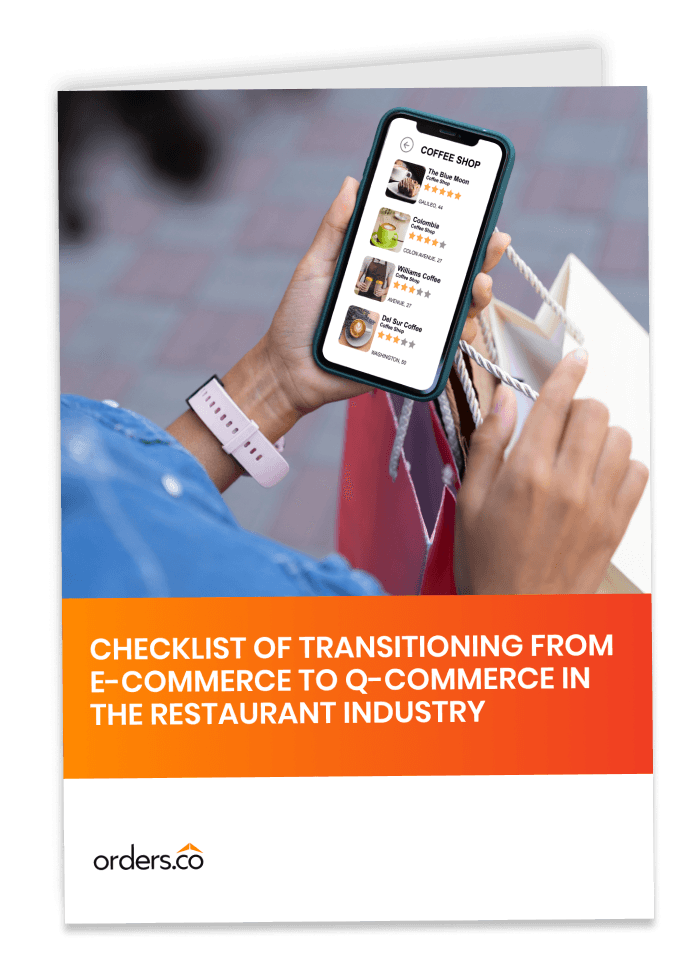- What is E-commerce, and what is Q-commerce?
- What are the main differences?
- The benefits of Q-commerce over E-commerce
- How to get started with Quick Commerce for your restaurant business
- The future of Q-commerce
In the early days of online retail, there was only eCommerce. Customers would browse through a company’s website, add items to their virtual shopping cart, and then complete their purchase by entering their payment information.
These days, however, there is a new player in the game: q-commerce. So what’s E-Commerce & what’s Q-Commerce?
Q-commerce stands for “quick commerce.” Rather than relying on traditional methods like websites and shopping carts, quick Commerce players use quantum computers to streamline the online shopping experience.
By harnessing the power of quantum computers, quick Commerce can offer customers Near-instantaneous results with zero waiting time. In addition, Q-commerce is more secure than traditional eCommerce platforms, thanks to its use of fulfillment centers that are designed with cutting-edge security measures, making it the preferred choice for many online shoppers.
As an on-demand delivery service, q-commerce is also changing the way we shop for food and other necessities. Rather than having to go to the store and wait in line, customers can now order their groceries and have them delivered to their door within minutes through dark stores.
To facilitate this, q-commerce relies on larger delivery vehicles to transport a greater volume of goods, making the operation more efficient and allowing for quicker deliveries.
So what’s the difference between Quick commerce (q-commerce) and eCommerce? Keep on reading to find out!
What is E-commerce, and what is Q-commerce?
E-commerce refers to the buying and selling of goods or services over the internet. When you buy something from Amazon, that’s e-commerce.
When you book a vacation on Expedia, that’s e-commerce too. E-commerce also includes things like online banking and bill pay. You might also hear e-commerce as “electronic commerce” or “internet commerce.”
Q-commerce is a newer type of e-business driven by the rise of mobile Commerce and voice-activated devices like Amazon Echo and Google Home. Q-commerce stands for “quick commerce,” and it refers to using quantum computing to power e-commerce transactions.
By using quantum computers, businesses could process large amounts of data more quickly and efficiently, leading to faster and more accurate decision-making. As the world increasingly goes towards a digital economy, a quick commerce business model is expected to significantly power e-commerce transactions.
While e-commerce requires customers to visit a website or app, q-commerce allows customers to make purchases through a conversational interface.
This can be convenient for those who are on the go or simply prefer not to use a traditional web-based purchase process.
So far, as a new business model q-commerce has been most commonly used for purchasing everyday items such as food and household supplies. Still, it has also been used for booking travel and making restaurant reservations.
As q-commerce continues to evolve, we’ll likely see more innovative uses for this technology.
What are the main differences?
Q-commerce can be defined as a type of e-commerce, which is the buying and selling of goods and services over the internet. However, there are some key differences between these two.
For one, Q-commerce focuses on providing a more seamless and convenient customer experience. This means that orders can be placed quickly and easily without needing to fill out lengthy forms or browse through pages of products.
In addition, Q-commerce often uses artificial intelligence (AI) to provide personalized recommendations and suggestions. As a result, customers can find exactly what they’re looking for in a fraction of the time it would take on a traditional e-commerce website.
Q-commerce is mobile-friendly, making it easy for customers to shop on the go. All of these factors combine to create a shopping experience that is both faster and more convenient than traditional e-commerce.
Ultimately, Q-commerce companies represent the future of online shopping, and it is only a matter of time before more businesses start offering this convenient and personal form of shopping.
Quick Commerce is the new frontier of online shopping and promises to revolutionize how we purchase goods and services.
The benefits of Q-commerce over E-commerce.
Q-Commerce, or quick Commerce, uses quantum mechanics to speed up transactions and improve security.
Unlike traditional E-Commerce, which relies on classical physics, Q-Commerce takes advantage of the strange properties of quantum particles to transmit information instantaneously over long distances.
This makes it possible to conduct transactions at the speed of light without needing a central server or network. As a result, Q-Commerce has the potential to change the way we shop online.
Traditional e-commerce relies on encryption to protect sensitive information like credit card numbers and passwords. However, quantum computers can easily break through such encryption schemes.
Q-commerce remedies this problem by using quantum key distribution (QKD), which is impossible to hack. With QKD, each transaction is assigned a unique key that is destroyed after use. This makes it impossible for hackers to intercept and decode information.
Another advantage of q-commerce is its ability to scale. Unlike traditional e-commerce systems, which can become overloaded during peak times, q-commerce can easily handle large numbers of transactions simultaneously.
This is because each transaction is processed independently without needing a central server or network. As a result, C-Commerce can offer customers a much smoother and more efficient shopping experience.
So overall, Q-commerce offers benefits, such as:
- Faster checkouts.
- More personalized recommendations.
- Easier mobile shopping.
- Improved scalability.
- Better security.
- The ability to handle large numbers of transactions simultaneously.
- A more convenient and seamless shopping experience for customers.
Your Inbox, Your Rules!
Tailor your newsletter with the topics you're most interested in.
Q commerce companies specialize in so-called last-mile delivery which is a type of Q-commerce allowing customers to receive their orders in the shortest possible time. This is made possible because each transaction is processed instantaneously, without the need for a central server or network.
As a result, last-mile delivery can offer customers the convenience of receiving their orders in minutes rather than hours or days. In addition, last-mile delivery is more environmentally friendly than traditional e-commerce for restaurants, as it eliminates the need for transportation and packaging.
How to get started with Quick Commerce for your restaurant business.
If you’re interested in using Q-commerce to speed up transactions and improve security for your restaurant business, there are a few things you need to do.
First, you’ll need to find a quantum computer. While there are a few different types of quantum computers on the market, they all serve the same purpose: to perform calculations at the speed of light.
Once you’ve found a quantum computer, you’ll need to install the Quick commerce software. This software will enable you to conduct transactions instantaneously without requiring a central server or network.
Finally, you’ll need to create a Quick commerce account. Once you’ve done this, you’ll be able to start using Q-commerce to speed up transactions and improve security for your restaurant business.
Q-commerce is the future of online shopping, and it’s only a matter of time before it becomes the norm.
If you’re interested in using Q-commerce to improve your restaurant business, now is the time to start.
The future of Q-commerce.
Q-commerce is the latest development in online shopping, changing the landscape of retail as we know it. Rather than relying on a website or a brick-and-mortar store, Q-commerce allows shoppers to purchase products directly from their favorite social media platforms.
And since most people are already spending hours scrolling through their daily feeds, this new shopping method is highly convenient. Quick Commerce also offers a unique opportunity for brands to connect with their customers more personally.
Rather than simply bombarding them with ads, brands can now use social media to start a conversation and build relationships. In the future, the q commerce business model will likely become even more popular as more brands adopt this innovative approach to retail.
Thanks to Quick Commerce, the future of shopping looks more convenient, personal, and engaging than ever before.
Check Orders Quick Commerce delivery management and optimization that allows employees to fulfill the orders and update item availability on one device. Just try it now!
Also, have a look at our complete guide to Q-Commerce.
Q-Commerce is Changing the Way We Shop
The way we shop is changing. In the past, shopping meant going to a store or browsing a website. But now, a new type of shopping is becoming popular: Q-commerce.
Q-Commerce space is the new way to shop. It’s quick, convenient, and allows you to shop from the comfort of your own home. With Q-Commerce, there’s no need to go to the store or stand in line.
You can shop from anywhere, at any time. And best of all, you can get your products delivered to your door. Q-Commerce is changing how we shop, and it will only get better.
With more and more businesses offering Q-Commerce fast delivery options, it’s only a matter of time before it becomes the new norm. So what are you waiting for?
Try Q-Commerce today!
Look for more blog posts here.




